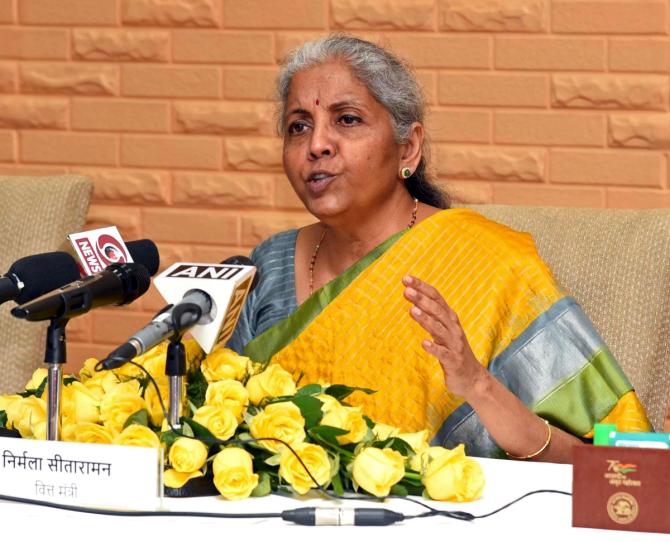
We may see market borrowings Rs 2 trillion-Rs 3 trillion less than projected
Macroeconomic management is usually a lot more comfortable with lower fiscal deficits. The sooner we get there, the better for the economy, says former Chief Economic Adviser to the Government of India Shankar Acharya.
Days after the Union Budget, pretty much every worthwhile comment (and many not so worthwhile ones!) has been made in all forms of media.
However, as a regular columnist, one feels obliged to declare one’s hand. So here goes.
First, it is important to recognise that the finance minister and her team were charged with making a Budget in an extremely challenging economic situation.
The economy had been hammered by the Covid pandemic and the strong initial lockdown in spring 2020, and although the output recovery since then had been quite good, it had been buffeted by the second and third waves of April-June 2021 (Delta) and December-January of 2021/22 (Omicron), respectively.
Furthermore, substantial scarring damage persisted in the form of record fiscal deficits and unprecedented debt-GDP ratios, high unemployment and under-employment (especially in the numerically dominant informal sector), stagnant aggregate consumption levels, stalled private investment and an uncertain global economic environment.
Aside from the strength of the formal sector output recovery, the rebound in exports and imports was a redeeming feature.
Against this background, I had hoped for a significant fiscal consolidation (perhaps close to a per cent of GDP), the continuation of FM’s refreshingly commendable commitment to transparency and proper accounting of Budget numbers, continuation of various special programmes to help the most badly hit sections of society (including informal sector workers and micro, small and medium enterprises), a significant, sustainable effort to raise the Centre’s gross tax ratio (stuck at 10-11 per cent of GDP for many years) through possible new taxes on the very rich (such as on capital gains, inheritance and wealth) as the only durable solution to our record deficit/debt problems, and significant trade policy reforms to consolidate and strengthen the rebound in foreign trade, especially in our long-stagnating merchandise exports.
As usual, some of my hopes were met and others belied.
The Budget does promise a modest fiscal consolidation of 0.5 per cent of GDP, down to 6.4 per cent from the Revised Estimate (RE) of 6.9 per cent.
Nirmala Sitharaman’s commitment to transparency in presenting the Budget numbers has continued, including in the detailed presentation of the cleaning up of the customs tariff schedule in the explanatory memorandum to the Finance Bill, although one misses the summary table of changes in effective customs duty rates appended to each of her three previous Budget speeches.
So has her commendable penchant for conservative fiscal projections of revenue and expenditure.
The special programmes to assist the pandemic-afflicted sections of the population have also been broadly maintained.
However, there are no new taxes on the super-rich or any other significant tax-raising measures, apparently in consonance with prime ministerial guidance.
Nor are there any marked reductions in our heightened protective customs duty structure, which militates against sustained growth of exports and successful global value chain participation.
On the other hand, there is a major expansion of capital expenditure, especially on basic infrastructure, which should impart significant multiplier demands for materials and labour and help strengthen the economy’s medium-term growth potential.
Let me revert to the worrisome issue of fiscal consolidation.
This Budget has been framed against the background of persistence, over three years, of record high fiscal deficits with the combined (Centre plus states) deficit over 13 per cent of GDP in 2020/21, about 11 per cent in 2021/22 and projected at over 10 per cent in 2022/23, and record government debt ratios around 85-90 per cent of GDP.
The adverse consequences are beginning to manifest.
First, interest payments of the Centre have jumped by nearly 40 per cent between 2020/21 and 2022/23, raising their share in total expenditure by a record 4.4 per cent points over these two years and correspondingly shrinking the share of non-interest expenditures from over 80 per cent to just 76 per cent.
With net market borrowings projected at Rs 11.6 trillion to finance the Centre’s deficit and interest rates beginning to rise because of both global and domestic factors, this unhealthy trend is likely to persist.
Second, in current conditions, this order of market borrowings will pose serious monetary and debt management problems to the Reserve Bank of India and will almost surely fan the inflationary potential of persistent excess liquidity in the system.
We must always remember that inflation hurts the poor the most, makes exports less competitive and is inimical to sustained economic growth.
Third, the risk of crowding out green shoots of private investment revival is not a chimera.
However, there may be a silver lining.
Just possibly, the FM’s welcome conservatism in estimating revenues and expenditures may have exaggerated the deficit-debt challenges a little.
First, based on published trends up through December 2021, the REs for revenues may be underestimates and those for expenditures may be overestimates, thus possibly yielding a sizable government cash balance by end March, which could significantly reduce the scale of market borrowings in 2022/23.
Second, the Budget’s projection of nominal GDP growth of 11 per cent in 2022/23 sits awkwardly with the Economic Survey’s expectation of 8-8.5 per cent real growth, as it would imply a GDP deflator increase of only 3 per cent or less, very different from the 8.4 per cent estimated by the National Statistical Office in its Advanced Estimates of National Income for 2021/22.
Bearing in mind the ‘low base effects’ because of Delta and Omicron in the several months of 2021/22, real GDP growth in 2022/23 could be around 7 per cent or so.
Furthermore, the GDP deflator is likely to be in the 6-7 per cent range.
Together, this suggests that nominal GDP growth in 2022/23 could well be around 13-14 per cent.
Assuming a reasonable tax revenue elasticity of unity, net taxes of the Centre could then be around Rs 0.7 trillion higher than estimated.
Allowing for some under-budgeting of expenditures for subsidies and MNREGA and over-budgeting of capital expenditures, it is possible that, other things equal, deficits and market borrowing requirements might be Rs 0.5 trillion less.
Adding a couple of trillion rupees of possible under-estimated cash balances, noted above, we might well see market borrowings Rs 2 trillion-Rs 3 trillion less than projected.
All this would certainly help. But let us remember that Budget Estimates are just that, and they can go awry for all sorts of reasons, including unforeseen domestic or international shocks.
The basic moral of the story is simple: Macroeconomic management is usually a lot more comfortable with lower fiscal deficits. The sooner we get there, the better for the economy.
- Union Budget 2022
Shankar Acharya is Honorary Professor at ICRIER and former Chief Economic Adviser to the Government of India. Views are personal
Feature Presentation: Rajesh Alva/Rediff.com
Source: Read Full Article

